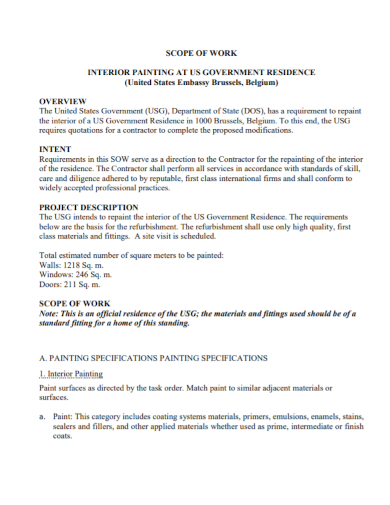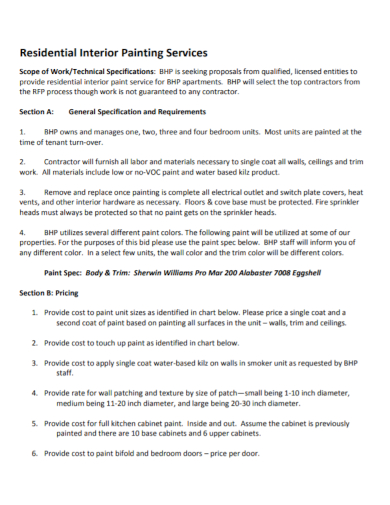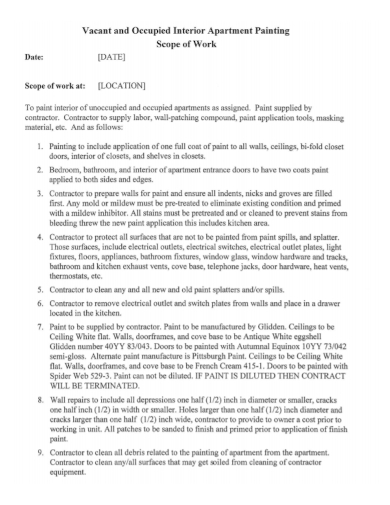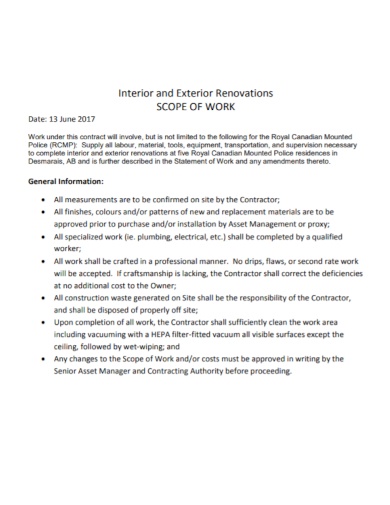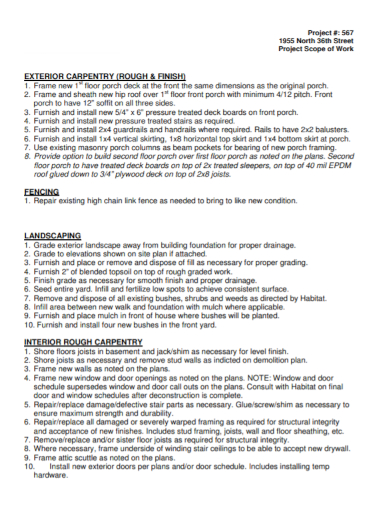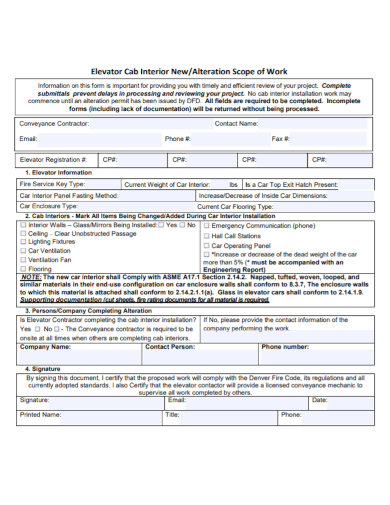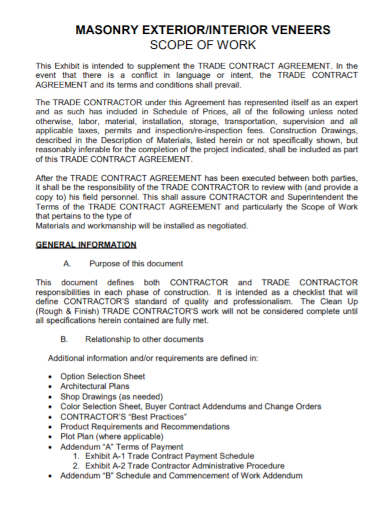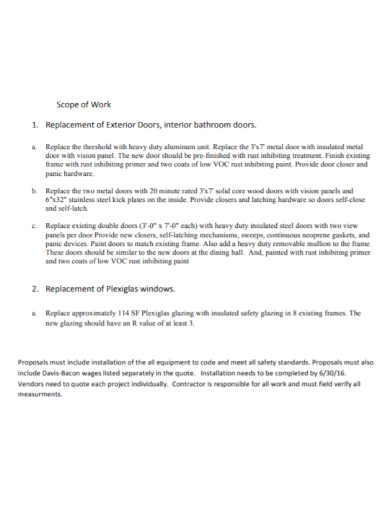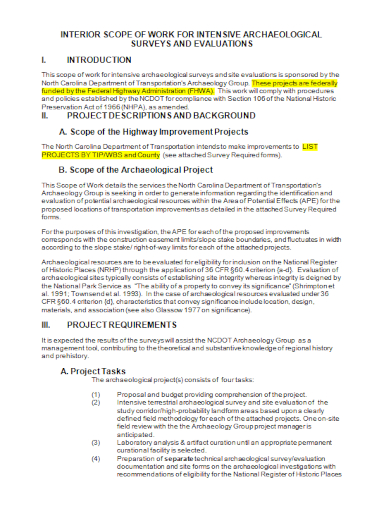Interior designers might be overlooked by some but many appreciate and respect their work, after all, they are responsible to create beautiful designs and decorations for interior spaces, and make an empty, drab, and listless room to be a comfortable ambiance and functional room to occupy in. These designers deal with a wide variety of clients asking for different, customized designs that is why a scope of work is needed to describe the particular work that interior designers must do. Read the article to find out how to make an interior scope of work.
10+ Interior Scope of Work Samples
1. Interior Painting Scope of Work
2. Interior Painting Services Scope of Work
3. Interior Apartment Painting Scope of Work
4. Interior Renovation Scope of Work
5. Interior Carpentry Scope of Work
6. Elevator Cab Interior Scope of Work
7. Masonry Interior Scope of Work
8. Interior Replacement Scope of Work
9. Interior Cleaning Scope of Work
10. Interior Bid Scope of Work
11. Interior Project Scope of Work
What is a Scope of Work?
Scope of work is one of the important parts of project documentation and agreements since it narrates a comprehensive description of a project’s work specifications and is a useful tool for measuring performance against project goals which is crucial for the success of the project. The scope of work lists down what tasks should be done, who is responsible for completing which task, in which timelines the tasks will take until its completed, and it provides extra details and conditions.
What Are the Details Included in the Interior Scope of Work?
1. Background Information
The first part of the work is a summary of the background of the interior designer’s business details and their client’s details. This is also where the scope of work shows that the designer and the client agree in doing the interior design project that will be done in the client’s building or home.
Add a definition of terms subheading if there are words, such as jargon, that are not generally understood but are going to be mentioned frequently in the scope of work.
2. Background of Work to be Done
The next part is to include a brief explanation of the reason why the interior project is done in the first place. Transition then on putting a more detailed explanation of the work to be done. You could explain the client’s vision of upgrading the interior design of their house or creating a new design theme for their coffee shop’s interior. This section must also include the total square footage and other measurements and an elaborate description of the area that will be transformed.
3. Work Description
The next part is to state the specific interior work to be done for the client. To give context, here are some examples of the duties and responsibilities of an interior designing team:
- Programming and Space Planning:
- Interview clients to determine their needs, schedules, and budgets
- Establish functional and aesthetic goals of the clients
- Inventory of existing furnishings and other items to be reused
- Provide space plans with furniture layouts
- Develop the project timeline
- Interior Design:
- Develop budgets on all interior improvements, finishes, and furnishings.
- Assist in material, finish, and furnishings analysis, recommendations, and specifications
- Design all interior details and coordinate interior plan selections and placement
- Provide sketches and presentation boards of interior selections and furnishings
- Review and coordinate furniture layouts with lighting and electrical plans
- Project Administration:
- Coordinate and review drawings with contractors
- Maintain project schedules
- Review all bids and pricing
- Provide on-site inspections during construction
- Assist with move-in
4. Objectives
The next part is the objectives, where you will describe the goals the designer should achieve on the job and the results they expect to happen.
5. Deliverables
The deliverables will determine the expected outcome of the project. It must list down the particular results of every aspect of the project.
6. Schedule
Interior designers must ensure their work is delivered on time. To achieve this, there should be a timeline of when the job will start and end. The schedule is where you put the day and time when the project will begin and end. Include also the duration of the job like how long will you, the designer, and your team do your work in a day and a week.
7. Payment
And lastly, the payment for the work must be emphasized. Include a schedule of when you’re getting paid for your services when you’re given money for the materials and tools you will use in your work. Putting the amount is not necessary to add, but you can add how you want to be paid by the client (whether through checks or cash). This must be discussed with the client first before putting it into writing.
FAQs
Where are interior designers employed?
Interior Designers usually get projects in these fields:
- Residential Projects: Project designs used for domestic accommodation.
- Workplace Projects: Project designs used for offices or factories.
- Temporary Exhibition Projects: Project designs used for temporary designs such as art galleries, museums, and various private and public projects.
- Commercial Projects: Project designs for retail businesses, warehouses, leisure and relaxation venues, conference centers, food and beverage sectors, hospitality sectors, universities, schools, and healthcare sectors.
How do you become an interior designer?
To pursue the occupation of an interior designer you need to do the following:
- Earn a degree in interior design.
- Pass the licensure exam for interior design.
- Accept some pro bono projects for the experience. This could also help you learn working in the industry and meet connections.
- Build a portfolio of your work.
- And lastly, always look for opportunities where you can grow.
What skills do you need to be an interior designer?
To be an interior design you need to have a creative eye and attention to detail, be interested to know the latest trends in interior design, do sustainable practices, know how to sketch well, and be great at organizing your workload and schedule.
Once you’re done writing your scope of work draft, make sure to remove and revise any grammatical and spelling errors. It must be presentable and easy to read. Show the scope of work to your client to discuss it further and reach a mutual agreement on the terms and condition of the scope of work. To help you get started making your own scope of work, why not use our free sample templates above? They are also editable and printable too so download one now!
Related Posts
Weekly Schedule Samples & Templates
Contractual Agreement Samples & Templates
FREE 9+ Amazing Sample Church Bulletin Templates in PSD | PDF
Sample Business Card Templates
Sample Cashier Job Descriptions
Questionnaire Samples
FREE 10+ Sample HR Resource Templates in PDF
FREE 10+ HR Consulting Business Plan Samples in MS Word | Google Docs | Pages | PDF
FREE 49+ Sample Job Descriptions in PDF | MS Word
FREE 16+ Nonprofit Budget Samples in PDF | MS Word | Excel | Google Docs | Google Sheets | Numbers | Pages
FREE 13+ Academic Calendar Templates in Google Docs | MS Word | Pages | PDF
FREE 10+ How to Create an Executive Summary Samples in Google Docs | MS Word | Pages | PDF
FREE 23+ Sample Event Calendar Templates in PDF | MS Word | Google Docs | Apple Pages
Company Profile Samples
FREE 10+ Leadership Report Samples [ Development, Training, Camp ]

